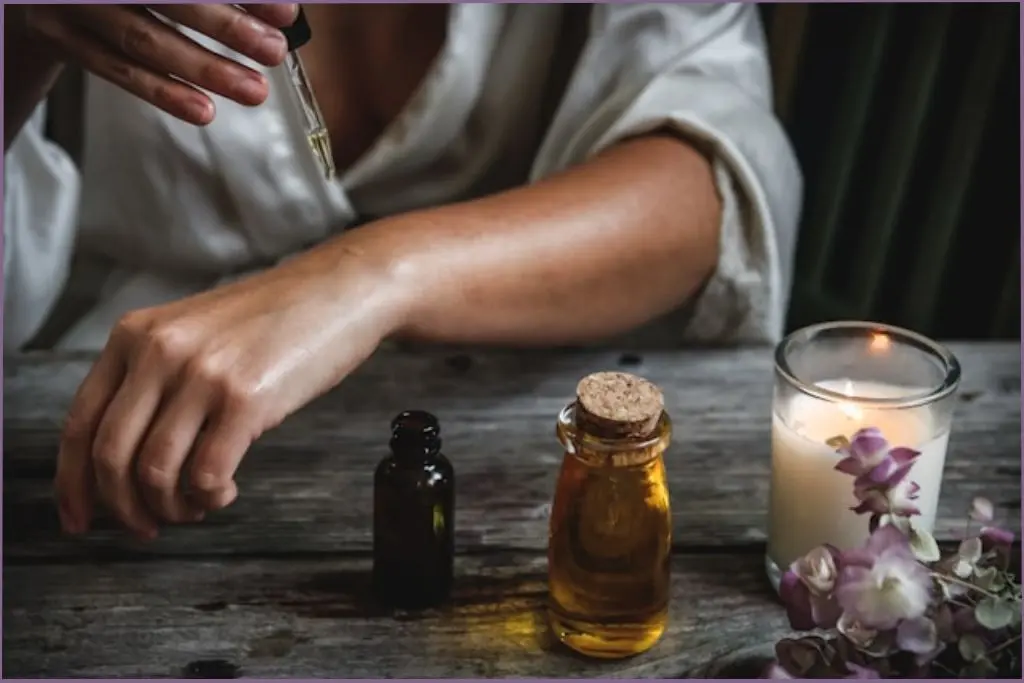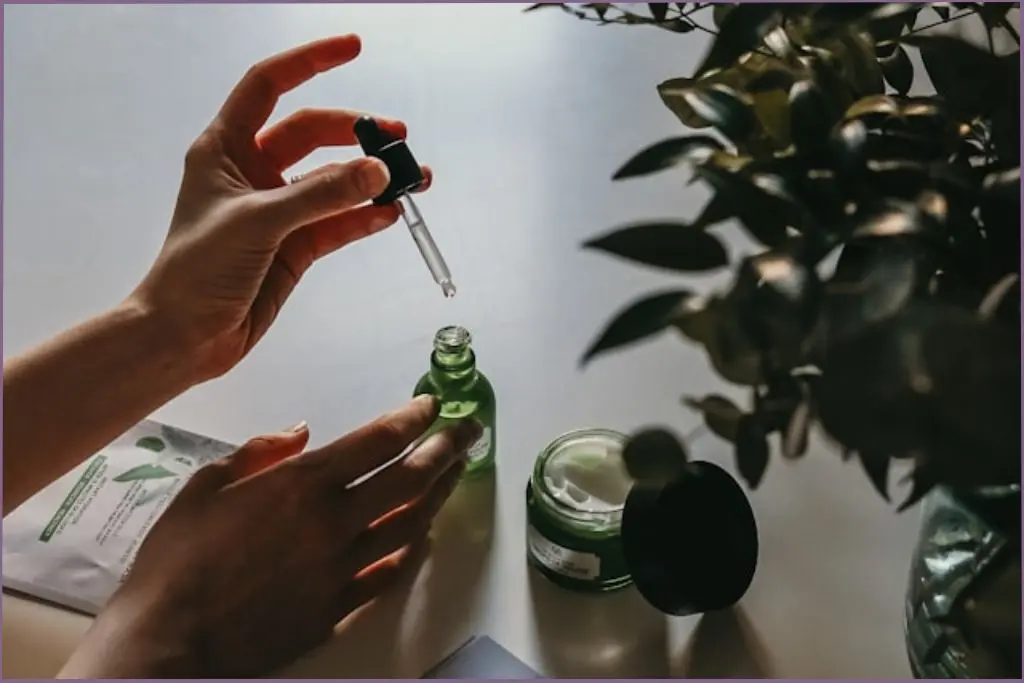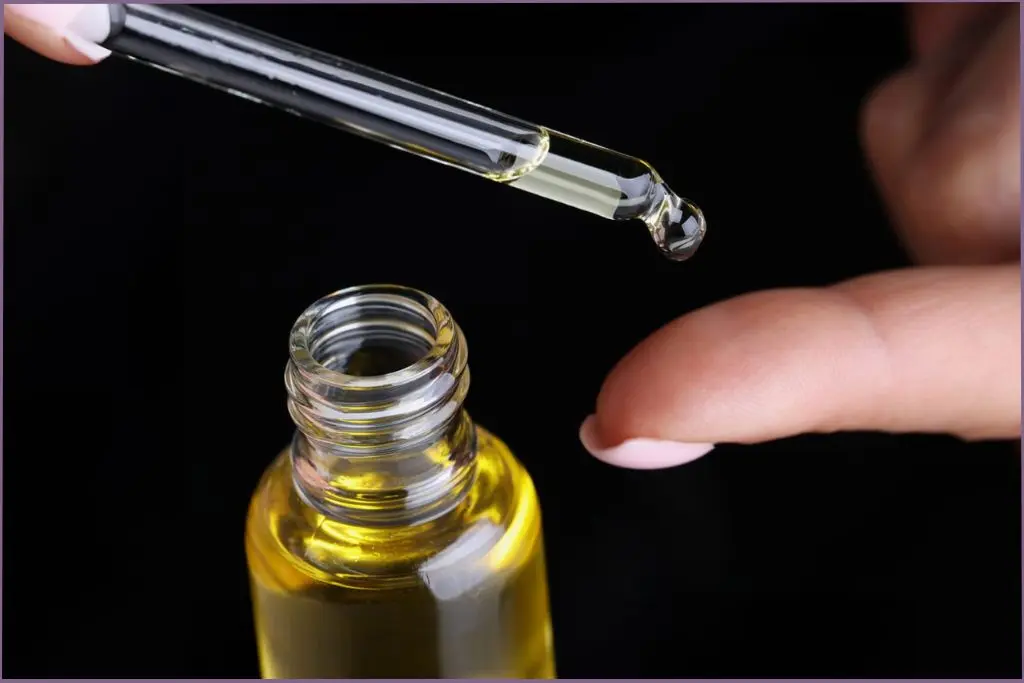As an Amazon Associate I earn from qualifying purchases. See Full Disclosure Here
Topical application of essential oils is a simple, quick, and effective way to enjoy the benefits of aromatherapy.
- Dilution using carrier oils is key when applying essential oils topically.
- Learning how to use essential oils on the skin correctly allows you to experience targeted, localized relief without the adverse effects.
Using essential oils topically is one of the simplest, fastest, and most effective ways to get the benefits of these aromatic compounds. Topical application involves applying diluted essential oil directly to the skin.

What makes topical application of essential oils so effective is that it allows you to target specific areas for desired effects. The specific benefit you experience will depend on the essential oil you use.
In addition, there are also many other ways to apply essential oils to the skin that can provide overall well-being for your entire body.
This is different from the way essential oils work when diffused and inhaled. While you can experience the benefits of aromatherapy by diffusing essential oils, it works differently. Inhaling the vapors offers overall benefits and not targeted, localized benefits.
Once you start using essential oils topically, you’ll see first-hand how it enhances your aromatherapy experience.
Important note: It is crucial to always dilute essential oils with carrier oil before topical application.
Benefits Of Using Essential Oils Topically

Essential oils have a low molecular weight, enabling them to penetrate the dermis and enter the bloodstream. When applied to the skin, essential oils can address internal issues and provide localized relief.
For example, using essential oils topically on pulse points can provide an energy boost or promote relaxation, depending on the specific oil used. Topical application is also effective for addressing physical issues such as sore muscles, headaches, skin irritations, bug bites, and more.
Due to their volatility, diluted essential oils evaporate quickly and reach the target area faster than some creams or lotions. This can lead to faster relief, which can be especially beneficial for reducing muscle aches or soothing insect bites.
This is one of many studies that found that topical essential oils are beneficial as an add-on treatment in reducing pain and stiffness in the investigated musculoskeletal disorders.
This study demonstrated that topical application of lavender essential oil promoted collagen synthesis and differentiation of fibroblasts, which have the potential to promote wound healing in the early phase. Researchers are exploring new approaches to using lavender essential oil as a complementary treatment for wound healing to complement conventional therapy.
How To Use Essential Oils On Skin For Localized Benefits

These are some of the many ways you can incorporate topical use into your daily routine. Read about the best pulse points for applying essential oils for fast and effective relief.
- Soothe Muscle Aches and Joint Pain: Gently massaging a diluted blend of peppermint, wintergreen, or rosemary with jojoba carrier oil to sore muscles or joints can provide a cooling and pain-relieving sensation at that area.
- Calm Insect Bites and Stings: Dabbing a diluted solution of tea tree or lavender essential oil on an insect bite offers immediate, localized relief from itching and swelling.
- Ease Headaches and Migraines: Gently massage any of these essential oils for headaches to your temples or the back of the neck to ease the pain and promote relaxation, potentially reducing migraine severity.
- Reduce Acne: This study suggests that tea tree essential oil is effective in reducing acne-related inflammatory lesions because of its strong antibacterial, anti-inflammatory, and antioxidant properties. Exercise extra care when using essential oils on face.
- Treat Minor Cuts and Scrapes: Tea tree oil, known for its antiseptic properties, can be diluted and applied topically to minor cuts, scratches, and scrapes to help prevent infection and promote healing. Note: DO NOT apply to open wounds. Consult a healthcare professional for any serious wounds.)
- Reduce Inflammation: Essential oils like chamomile and lavender have calming and soothing properties that can help reduce inflammation associated with conditions like eczema and psoriasis.
- Soothe Digestive Issues: Diluted peppermint oil applied to the stomach area may help soothe occasional nausea or indigestion.
- Ease Respiratory Ailments: Applying diluted eucalyptus oil to the chest can help ease congestion and promote easier breathing. (Avoid using eucalyptus oil with children or pregnant women.)
- Promote Sleep: Dabbing any of these essential oils for sleep on your temples or wrists before bed helps promote relaxation and potentially improves sleep quality.
- Improve Focus and Concentration: Rosemary oil diluted and applied to temples is sometimes used to enhance alertness and focus, though research is ongoing.
- Boost Nail & Cuticle Strength: Read about the best cuticle oils for strong nails and how to use them.
- Soothe sunburn: Diluted lavender oil may offer some relief from sunburn discomfort due to its potential anti-inflammatory properties. (Aloe vera is a more established remedy for sunburns.)
- Reduce Fungal Infections: Some research suggests diluted tea tree oil might be helpful against toenail fungus, although more studies are needed. (Consult a healthcare professional for diagnosis and treatment of fungal infections.)
- Improve Circulation: Certain essential oils like cypress or clary sage might be used diluted on legs or feet to improve circulation, although research is limited. (Consult a doctor for any concerns about circulation.)
Remember, while these are potential benefits, the effectiveness of essential oils can vary and more research is needed for many of these uses. It’s advisable to consult with a healthcare professional before using essential oils topically, especially if you have any underlying medical conditions.
Importance Of Diluting Essential Oils With Carrier Oils For Topical Application

Before getting into the different ways to apply essential oils to skin, it’s essential to prioritize safety.
Dilution with carrier oils is the most important of all precautions when using essential oils topically and deserves a section on its own.
Pure essential oils are highly concentrated extracts containing powerful plant compounds. Each drop is highly potent and can cause skin irritation and itching, or even burning, if used directly on the skin in its undiluted form.
To prevent any adverse reactions, it’s crucial to dilute essential oil with a carrier oil before applying it to your skin. Dilution with a carrier oil significantly reduces the concentration and makes the oil safer for topical use.
Carrier oils also provide additional benefits. They lessen the volatility of the essential oil that you use so it stays on the skin longer. They also make it easier to spread a few drops of essential oil over a larger area
There is a variety of carrier oils to choose from, including grapeseed oil, sweet almond oil, and jojoba oil. These oils not only enhance the absorption of essential oils but also offer their own skin-nourishing properties.
Every carrier oil offers its own distinct benefits. Jojoba oil is lightweight and suitable for oily skin, while sweet almond oil is gentle and universally applicable. Coconut oil offers deep hydration for dry skin. This article on the best carrier oils for essential oils covers can help.
How To Dilute Essential Oils For Skin + Dilution Ratios

There are two ways to dilute essential oils for skin:
1- If it’s for one-time use or occasional application, blend only one drop of essential oil with the recommended amount of carrier oil.
2- If it’s for regular use, blend a slightly larger quantity and store it in a dark-colored glass bottle. Do not blend very large quantities at a time as opening the bottle regularly exposes the essential oil component to light and air, degrading its therapeutic properties.
Here are some recommended dilution ratios based on age and specific circumstances:
• 0.5% dilution: Suitable for babies aged 3-24 months
• 1% dilution: Recommended for children aged 2-6 years
• 2% dilution: Safe for adults, older children, and elderly individuals
• 3%-5% dilution: For temporary use and specific needs
To achieve these dilution ratios, follow this guideline – 1 drop of essential oil to 1 teaspoon of carrier oil for a 1% dilution.
Adjust the number of drops accordingly to achieve the desired dilution ratio.
Always use a dropper when adding essential oil so you don’t accidentally add too much.
It’s always better to start with a lower dilution and gradually increase if needed.
This guide to diluting essential oils goes more in-depth into this topic complete with ratios, charts, and more.
Quality Matters When Buying Essential Oils for Topical Use
Buying high-quality essential oils is paramount, whether you’re using them topically or inhaling them.
Here are some key factors to consider:
Purity: Look for essential oils that are free from contaminants, fillers, or adulterants. Check if the brand offers access to third-party testing reports that provide assurance of purity.
Botanical Source: The plant species and its origin can significantly impact the oil’s properties. Opt for essential oils that clearly state the botanical name and source.
Distillation Method: Different distillation methods can affect the potency and therapeutic value of the oil. Look for brands that specify the distillation method used (e.g., steam distillation).
Organic Certification: While not always a guarantee of quality, organic certification indicates the plants were grown without synthetic pesticides or fertilizers.
Prioritizing these factors ensures that you are getting safe and effective essential oils for topical use. Remember, a reputable brand will be transparent about these aspects and readily provide information about their products.
Plant Therapy ticks all the boxes listed above and that’s why they are my #1 recommended essential oil brand.
You can also use unscented natural lotions or soaps as carriers for your essential oils. By diluting essential oils with carrier oils, you not only ensure safety but also make your oils last longer, as you can achieve the desired
Topical Application Of Essential Oils: Precautions

- Patch Test: Before applying any new essential oil over on a larger area, it’s advisable to perform a patch test. Apply a diluted drop (1 drop essential oil + 4 drops carrier oil) to a small area on your inner forearm. Monitor for reactions such as redness, itching, or burning over 24 hours. This is to determine if you are sensitive to that particular oil before proceeding with wider application.
- Photosensitivity: Citrus essential oils including lemon, grapefruit, bergamot, and lemongrass can cause photosensitivity. Avoid direct sunlight or UV exposure for up to 12 hours after applying these oils topically. Consider using them in the evening or in areas of the body not exposed to sunlight.
- Allergies and Sensitivities: If you have known allergies or sensitivities to specific plants, chances are you will be allergic to the essential oil extracted from those plants. Performing a patch test can help.
- Pregnancy and Breastfeeding: Consult a healthcare professional before using essential oils if you are pregnant or breastfeeding due to potential risks.
- Children: Avoid using essential oils on young children without consulting a pediatrician. For older children, I highly recommend using only KidSafe essential oils, which are specially formulated for kids’ gentle skin.
- Using Essential Oils on Face: Facial skin is delicate, so extra dilution and a patch test are crucial before using essential oils on the face.
- Hot Oils: Some essential oils, like cinnamon, clove, and oregano, are considered “hot” and may cause skin irritation if not properly diluted. Always dilute these oils and follow the recommended guidelines.
- Open Wounds and Damaged Skin: Do not apply essential oils, even highly diluted, to open wounds, broken skin, or mucous membranes (eyes, nose, mouth).
- Storage and Shelf Life: Store essential oils properly in dark, glass bottles away from direct sunlight and heat. Check the shelf life of your oils and discard any that have expired.
Choosing The Best Essential Oil For Specific Purposes
These are some essential oils that are commonly used in topical applications.
This is not an exhaustive list, and there are numerous essential oils with their own unique benefits. Here are a few examples:
- Lavender: Known for its calming and soothing properties, lavender oil is a versatile option for topical use. It can help with relaxation, sleep, skin irritations, and minor burns.
- Peppermint: With its refreshing and cooling effects, peppermint essential oil is often used topically for headaches, muscle pain, and digestive discomfort.
- Tea Tree: Tea tree essential oil is well-known for its antibacterial and antifungal properties. It can be applied topically to address acne, skin infections, and insect bites.
- Eucalyptus: Eucalyptus essential oil is widely used for respiratory issues, muscle pain, and as a powerful decongestant. Its invigorating scent is also favored in spa treatments.
- Frankincense: Frankincense essential oil is known for its skin rejuvenating properties and can be applied topically to promote a youthful complexion and reduce the appearance of scars.
Remember to research each essential oil and its specific uses, as some oils may require additional precautions or have specific contraindications.
Whether you choose to incorporate essential oils into your massage routine, create your own natural perfume, or apply them as a soothing balm, the possibilities are endless. Remember to prioritize safety by diluting essential oils with carrier oils and following recommended guidelines. Listen to your body and adjust your routine as needed.
As you embark on your journey with essential oils, explore different blends, experiment with various applications, and discover what works best for you. Stay curious, keep learning, and enjoy the incredible benefits that essential oils can bring to your life. Embrace the power of topical use, and let the magic of essential oils enhance your well-being naturally.
Disclaimer: This information is not intended to serve as medical advice. Please consult your doctor before using any natural medication or if you experience any unusual symptoms. See Full Disclaimer here.








Leave a Reply